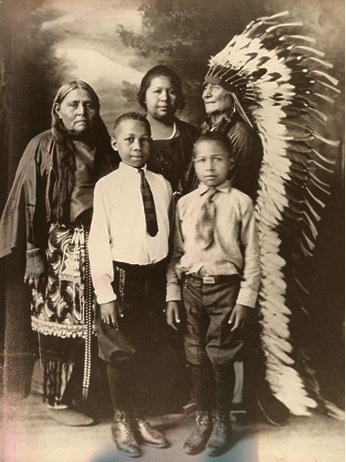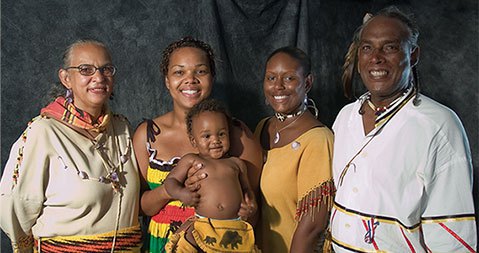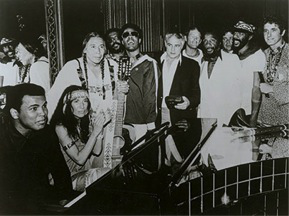InDivisible:
The Story of Black Native American People
by Amanda Crabbe
Here is a family from the Comanche Nation located in southwestern Oklahoma. This photo exemplifies the mixed culture and history of the Black Native American people. As a result of years of enslavement and discrimination, Africans and Native Americans created a unique ethnicity, often unheard-of in American History.
“In fourteen hundred ninety-two, Columbus sailed the Ocean blue. He had three ships and left from Spain; he sailed through sunshine, wind and rain.” We have all heard this children’s rhyme, teaching young minds about the “founding” of America by Christopher Columbus. This song is about exploration, bravery and the discovery of America. We are encouraged to feel grateful and inspired by this feat. However, rarely in American History, do we learn about those who were already living on that land, the Native Americans. And what we do learn depicts them as savages: simple minded people who were centuries behind their European conqueror’s. However, the arrival of these Spanish ships truly wreaked havoc on their lives, causing irrevocable damage to Native American livelihood for future generations to come.
European colonizers quickly began to seize the Native Americans’ land, and enslave their people. The slave trade was introduced as the need for laborers increased. Sea traders kidnapped Africans and shipped them across the Atlantic to be sold as slaves. Those who ruled the colonies created laws and policies that treated Africans and Native Americans as inferior to the White European settlers. It is this shared history and struggle for civil rights that creates the lesser-known Black Native American culture. The exhibition IndiVisible: Black Native American Lives in the Americas is the story of the interwoven lives of Native Americans and Africans in America. This collaboration is between the Smithsonian’s National Museum of the American Indian, National Museum of African American History and Culture, and the Smithsonian Institution Travelling Exhibition Service (SITES).
IndiVisible seeks to dispel the savage stereotype by explaining the existence of diverse societies in Africa and the Americas prior to European conquest. In fact, within this hemisphere, there were hundreds of Native nations, each with its own spirituality, language, system of government and land. Similarly, in Africa, societies ranged from advanced kingdoms to hunter-gatherer communities, also with tribal, religious and linguistic differences. There were many similarities as well, including beliefs about animal spirits, guiding ancestors, traditions and the importance of extended families.
African Americans and Native Americans were sometimes enslaved together. Utilizing their similar beliefs and strengths, they banded with one another to overthrow their captives. Similarly, when African Americans began escaping slavery, they found support in many Native American communities. Being adopted in the tribal homelands, they were safe from invasion. Collaboratively, they worked together to preserve their freedom. Oftentimes, African Americans would become members of the Native American tribes, mixing both cultures, and creating a new group of African Native Americans.
Fast forward to the civil rights movement, a movement that pushed for the full inclusion of African American citizens as independent, constructive members of American society. The Native American rights movement hoped to achieve similar goals. Native Americans wanted to be viewed as American citizens,while also gaining sovereignty for Native nations. Native and African American activists fought against racism, violence, and poverty. Those of African Native American descent closed the gaps between these two movements, bringing together people from both sides and proving that their similar struggle could be overcome with collaboration.
Alliance between African Americans and Native Americans continued to grow with the Black Power movement of the 1970’s. Pictured above (left to right) are Muhammad Ali, Buffy St. Marie, Floyd Red Crow Westerman, Harold Smith, Stevie Wonder, Marlon Brando, Max Gail, Dick Gregory, Richie Havens, and David Amram. This photo was taken at a concert which culminated the end of the Longest Walk, a 3,600-mile protest march from San Francisco to Washington D.C. in the name of Native Rights.
Today, Black Native Americans struggle to come to terms with their identity. African Americans of mixed race are often pressured into choosing a single racial identity. Historically, there were laws and customs that stated that any race of African ancestry made you Black, regardless of the color of your skin. However, this “one-drop” rule only applied to African Americans. It therefore served to exclude Native African Americans from both European Americans and Native Americans. This sometimes caused Black Native Americans to feel unaccepted and isolated, unfortunately missing an opportunity to embrace a rich cultural ancestry.
Despite hardships and adversities, the combinations of flavors, stories, art, and rhythms create an extraordinary rich culture. Black Native American people have brought together the better of two ancient continents, crafting a unique ethnicity. In fact, these two cultures continue to influence each other in a variety of ways. Black Native American hip hop artists promote the voice of the silenced people. Ancestral roots inspire painters and sculptors. Writers forge through racial boundaries. Overall, the pursuit of creativity generates acknowledgement and acceptance for a long forgotten people.
+++++++++++
Amanda Crabbe is a Nonprofit Management Degree Candidate at the New School for Public Engagement




